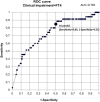Thyroxine Threshold Is Linked to Impaired Outcomes in Preterm Infants
- PMID: 32432068
- PMCID: PMC7216369
- DOI: 10.3389/fped.2020.00224
Thyroxine Threshold Is Linked to Impaired Outcomes in Preterm Infants
Abstract
Transient hypothyroxinaemia of prematurity (THOP) presents as decreased free thyroxine without an increase in thyroid stimulating hormone. Thyroxine availability is important in case of premature birth, and THOP could be associated with impaired adaptation to extra-uterine life but the association of thyroxine level and clinical status has not yet been clearly defined. Aim: To defined a free thyroxine threshold likely associated with neonatal clinical impairment and outcomes at age three years. Methods: This retrospective cohort study included infants born before or at 28 weeks' gestation at the Regional Maternity in Nancy, France. We defined a free thyroxine threshold as a function of clinical impairment by Receiver Operating Curve analysis, validated by log likelihood iteration in binary logistic regression, in infants born from October 2008 to December 2012 and meeting neonatal clinical impairment criteria. This threshold was validated in a distinct cohort of infants born from January 2014 to December 2016. Clinical impairment was defined as assisted ventilation requirement at seven days of age plus four minor clinical disorders among heart rate, blood pressure, temperature, serum sodium and potassium, APGAR score at five minutes, vasopressor treatment and patent ductus arteriosus. The first cohort was assessed at age three years for neurodevelopmental outcomes. Results: We identified a ≤10 pmol/L threshold with 85.7% sensitivity and 51% specificity. From the first and second cohorts, 196 and 176 infants respectively had available data, and 85% (97/112) and 26% (20/78) with free thyroxine ≤10 pmol/L met clinical impairment criteria. For infants with values >10 pmol/L, 41% (35/84) and 3% (3/98) from the first and second cohorts met impairment criteria. Of 147 children with available data at age 3 years, 65% (58/89) with neonatal free thyroxine ≤10 pmol/L had adverse neurodevelopmental outcomes vs. 34% (20/58) with >10 pmol/L (OR 3.55; 95% confidence interval, 1.77-7.13; p < 0.001). Conclusion: A free thyroxine level ≤10 pmol/L in infants is associated with neonatal clinical impairment and poor outcome at age three years.
Keywords: clinical status; extremely preterm; outcomes; threshold; transient hypothyroxinaemia.
Copyright © 2020 Coquelet, Deforge and Hascoët.
Figures
References
LinkOut - more resources
Full Text Sources
Miscellaneous



